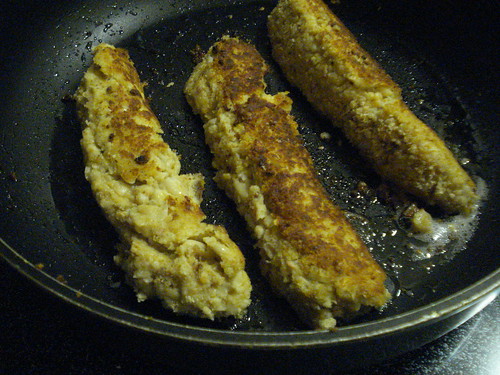mock sausage
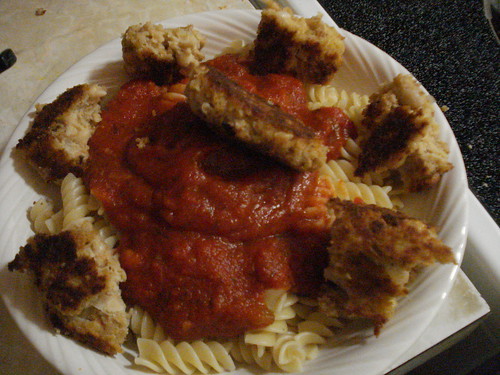 New Delineator Recipes is a slim volume published in 1930. I got it for the Recipes of the Damned; the volume is rife with under-seasoned recipes. I decided against a pot roast in which the only additional seasoning is the inherent flavor in the pork fat you use to brown the meat; I decided against the peanut-butter cutlets from the chapter of vegetarian dishes. (It’s sort of like French
New Delineator Recipes is a slim volume published in 1930. I got it for the Recipes of the Damned; the volume is rife with under-seasoned recipes. I decided against a pot roast in which the only additional seasoning is the inherent flavor in the pork fat you use to brown the meat; I decided against the peanut-butter cutlets from the chapter of vegetarian dishes. (It’s sort of like French 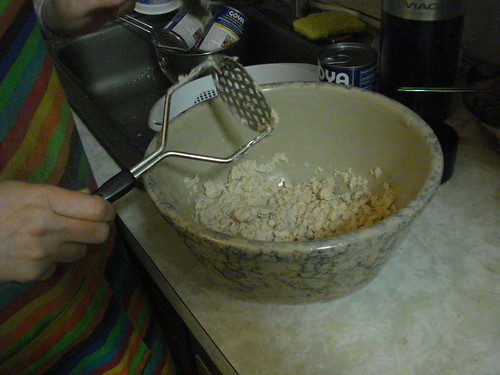 toast only with a peanut butter mixture instead of an egg batter.)
toast only with a peanut butter mixture instead of an egg batter.)
But the vegetarian dishes intrigued me. We’re accustomed to seeing Boca Burgers and Gardenburgers in the freezers of even small grocery stores now, but it’s been within my adult life that vegetarian meat substitutes really made an incursion onto the market, spurred by the national 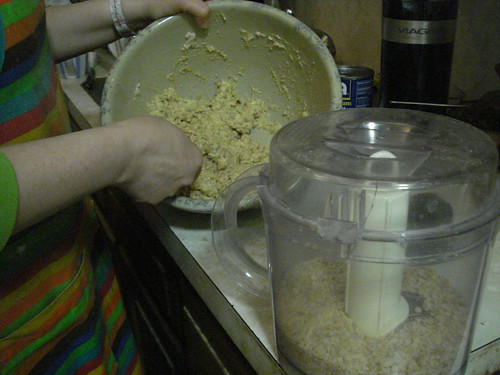 spread of Gardenburgers from Portland, Oregon. (I remember the first year’s worth of Morningstar Farms offerings — frankly, inedible, but they quickly reworked their recipes and now produce some palatable products.) Would a 1930 recipe, I wonder, really be worth eating? Depression-era cookery would of course benefit from lower-cost substitutions for meat, but that
spread of Gardenburgers from Portland, Oregon. (I remember the first year’s worth of Morningstar Farms offerings — frankly, inedible, but they quickly reworked their recipes and now produce some palatable products.) Would a 1930 recipe, I wonder, really be worth eating? Depression-era cookery would of course benefit from lower-cost substitutions for meat, but that  didn’t necessarily mean they’d be any good.
didn’t necessarily mean they’d be any good.
New Delineator author Ann Batchelder seems to have studied at the Miss Leslie school of vague instruction. Mock sausage is based on cooked beans, which the recipe says to force through a strainer. I used canned Great Northern beans, and quickly found that pushing them through 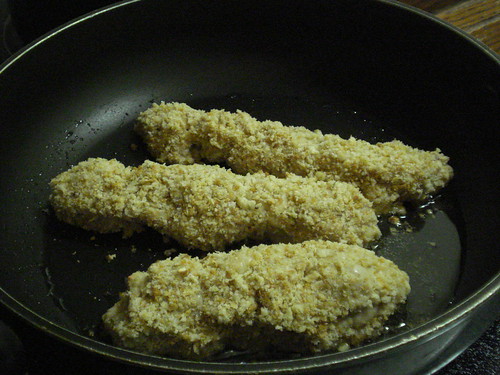 a strainer was not going to be easy. A fine sieve was too much for the beans, which didn’t get through at all; a fine-holed metal colander was a bit easier, but still promised to keep me working for half an hour or so. I decided to mash the beans with a potato masher, though in retrospect I should probably have pulsed them in the food processor. It also occurred to me later that the
a strainer was not going to be easy. A fine sieve was too much for the beans, which didn’t get through at all; a fine-holed metal colander was a bit easier, but still promised to keep me working for half an hour or so. I decided to mash the beans with a potato masher, though in retrospect I should probably have pulsed them in the food processor. It also occurred to me later that the 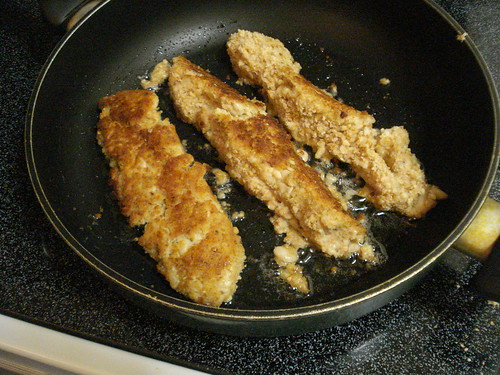 1930 definition of “cooked until tender” was probably a bit softer than the canned beans, and I might have had an easier time if I’d cooked the beans longer.
1930 definition of “cooked until tender” was probably a bit softer than the canned beans, and I might have had an easier time if I’d cooked the beans longer.
The other listed ingredients are these (spelling original):
After the beans are strained, the recipe says, “Add remaining ingredients, shape into form of sausages, roll in crums, egg, and crums again.” Go back and read that again. We have a metaphysical issue here. One is  supposed to add the remaining ingredients, yet somehow magically know which ones to save out to coat the shaped links. I proceeded on the assumption that one was supposed to add everything and then use extra bread crumbs, but this turned out to be incorrect. The mixture was wet and sticky, and did not hang together. Possibly the idea was to mix the beans with the butter, sage, and salt and pepper, and the roll it in the eggs and crumbs. Possibly I should have mixed in two of the eggs and used the third for rolling. The privilege of a cookbook author is that if she has a specific result in mind, she can specify what should be done.
supposed to add the remaining ingredients, yet somehow magically know which ones to save out to coat the shaped links. I proceeded on the assumption that one was supposed to add everything and then use extra bread crumbs, but this turned out to be incorrect. The mixture was wet and sticky, and did not hang together. Possibly the idea was to mix the beans with the butter, sage, and salt and pepper, and the roll it in the eggs and crumbs. Possibly I should have mixed in two of the eggs and used the third for rolling. The privilege of a cookbook author is that if she has a specific result in mind, she can specify what should be done.
I mixed in some more bread crumbs until the mixture held together fairly well, then shaped six links (the number recommended in the recipe) and rolled them in some more crumbs. This also was a misjudgment, because the links were too large to turn in the pan without breaking. If I were to do this again (the odds are dwindling at this point), I would make more and smaller links, possibly about the size of a Brown ‘n Serve breakfast link, or I’d make meatballs. Still, I pushed onward, and browned the mock sausages in some oil. The cooked links had a good texture; it was impossible to move the long links around without breaking them, but the shorter segments held together well.
The recipe recommends serving them “with tomato sauce,” so I cooked rotini and some Newman’s Own sauce and topped them with pieces of the mock sausage. They tasted all right; in my exasperation with the texture I had forgotten to add salt and pepper and they needed it badly, and they would have benefited from more sage, but the basic flavor was agreeable.
Verdict: Passable. This wasn’t as disastrous as Miss Leslie’s jelly puffs, but I have better fake-burger and fake-sausage recipes on hand.
